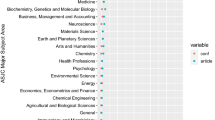Abstract
We present an application of a clustering technique to a large original dataset of SCI publications which is capable at disentangling the different research lines followed by a scientist, their duration over time and the intensity of effort devoted to each of them. Information is obtained by means of software-assisted content analysis, based on the co-occurrence of words in the full abstract and title of a set of SCI publications authored by 650 American star-physicists across 17 years. We estimated that scientists in our dataset over the time span contributed on average to 16 different research lines lasting on average 3.5 years and published nearly 5 publications in each single line of research. The technique is potentially useful for scholars studying science and the research community, as well as for research agencies, to evaluate if the scientist is new to the topic and for librarians, to collect timely biographic information.








Similar content being viewed by others
References
Agrawal, A., & Henderson, R. (2002). Putting patents in context: Exploring knowledge transfer from MIT. Management Science , 48(1), 44–60.
Allison, P. D., & Stewart, J. A. (1974). Productivity differences among scientists: Evidence for accumulative advantage. American Sociological Review, 39(4), 596–606.
Cole, S., & Cole, J. R. (1967). Scientific output and recognition: A study in the operation of the reward system in science. American Sociological Review, 32(3), 377–390.
Courtial, J. P., Sigogneau, A., & Callon, M. (1997). Identifying strategic sciences and technologies through scientometrics. In W. B. Ahston & R. A. Klavans (Eds.), Keeping abreast of science and technology, technical intelligence for business. Columbus, OH: Battelle Press.
Crane, D. (1972). Invisible colleges. Diffusion of knowledge in scientific communities. Chicago & London: The University of Chicago Press.
Fox, M. F. (1983). Publication productivity among scientists: A critical review. Social Studies of Science, 13(2), 285–305.
Garfield, E. (1979). Citation indexing: Its theory and application in science, technology and humanities. New York: Wiley.
Garner, C. A. (1979). Academic publication, market signaling and scientific research decisions. Economic Inquiry, 17(4), 575–584.
Gibbons, M., Limoges, C., Nowotny, H., Schwartzman, S., Scott, P., & Trow, M. (1994). The new production of knowledge. The dynamics of science and research in contemporary society. NY: Sage Publications.
Godin, B. (2003). The emergence of S&T indicators: Why did governments supplement statistics with indicators? Research Policy, 32, 679–691.
Hackett, E. J. (2005). Essential tensions: Identity, control, and risk in research. Social Studies of Science, 35(5), 787–826.
Hackett, E. J., Conz, D., Parker, J., Bashford, J., & DeLay, S. (2004). Tokamaks and turbulence: Research ensembles, policy and technoscientific work. Research Policy, 33(5), 747–767.
Hagstrom, W. O. (1965). The scientific community. New York, London: Basic Books Inc.
Hicks, D., & Hamilton, K. (1999). Does University-Industry collaboration adversely affect University research? Issues in Science and Technology Online, Summer 1999, 74-75, http://www.nap.edu/issues/15.4/images/realnum_big.jpg.
Klavans, R., & Boyack, K. W. (2005). Generation of large-scale maps of science and associated indicators. SANDIA Report SAND2005-7538, 01 Dec 2005.
Levi Montalcini, R. (1988). In praise of imperfection: My life and work. Alfred P. Sloan Foundation Series, New York: Basic Books.
Leydesdorff, L. (2002). Indicators of structural change in the dynamics of science: Entropy statistics of the SCI Journal Citation Reports. Scientometrics, 53(1), 131–159.
Manning, C., & Schütze, H. (1999). Foundations of statistical natural language processing. Cambridge: MIT Press.
Merton, R. K. (1968). The Matthew effect in science. Science, New Series, 159(3810), 56–63.
Moed, H. F., Burger, W. J. M., Frankfort, J. G., & Van Raan, A. F. J. (1985). The use of bibliometric data for the measurement of university research performance. Research Policy, 14, 131–149.
Murray, F., & Stern, S. (2007). Do formal intellectual property rights hinder the free flow of scientific knowledge? An empirical test of the anti-commons hypothesis. Journal of Economic Behavior & Organization, 63, 648–687.
Narin, F., & Hamilton, K. S. (1996). Bibliometric performance measures. Scientometrics, 36(3), 293–310.
Narin, F., Pinski, G., & Gee, H. H. (1976). Structure of the biomedical literature. Journal of the American Society for Information Science, 25, 45.
Peritz, B. C. (1992). On the objectives of citation analysis: Problems of theory and method. Journal of the American Society for information Science, 43(6), 448–451.
Porter, M. F. (1980). An algorithm for suffix stripping. Program, 14(3), 130–137.
Rasmussen, E. (1992). Clustering Algorithms. In N. Frakes & Baeza-Yates (Eds.), Information retrieval: Data structures & algorithms. New Jersey: Prentice Hall.
Salton, G. (1989). Automatic text processing: The transformation, analysis, and retrieval of information by computer. Reading, MA: Addison Wesley.
Stephan, P. E., & Levin, S. G. (1992). Striking the Mother Lode in science: The importance of age, place, and time. : Oxford University Press.
Ziman, J. M. (1968). Public knowledge: An essay concerning the social dimension of science. London, Cambridge: University Press.
Acknowledgements
This work was supported by the CERIS, National Research Council of Italy and was done while one of the authors (Chiara Franzoni) was kindly gusted as visiting scholar at the Andrew Young School of Policy Studies (Georgia State University, Atlanta, GA). The authors wish to thank Paula Stephan and Francesco Lissoni for comments and suggestions. All usual disclaims apply.
Author information
Authors and Affiliations
Corresponding author
Rights and permissions
About this article
Cite this article
Franzoni, C., Simpkins, C.L., Li, B. et al. Using content analysis to investigate the research paths chosen by scientists over time. Scientometrics 83, 321–335 (2010). https://doi.org/10.1007/s11192-009-0061-7
Received:
Published:
Issue Date:
DOI: https://doi.org/10.1007/s11192-009-0061-7




